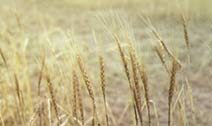Boron deficiency in barley

Boron deficiency causes similar symptoms in wheat, barley, oats, and rye.
Small chlorotic spots form between the veins of the youngest unfolded leaves. The spots enlarge and coalesce to form the characteristic white stripes. The stripes do not develop on mature leaves. Leaf unfolding is likely to be delayed and abnormal. Sterility of ears occurs, probably as a result of impairment of pollen germination and growth.
Some increased tillering may be observed and internodes can be short. There are indications that boron deficient wheat and barley is more susceptible to mildew (Erysiphe graminis) than healthy plants.
Boron applications have been known to reduce the incidence of ergot (Claviceps purpurea) on barley. It is likely that infection is facilitated by the sterility of the flowers and by the open configuration of the spikelets when boron is deficient.